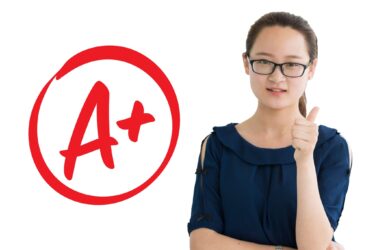
Transitioning from PSLE Math to Secondary Math may seem challenging, but it’s a positive opportunity for growth for both students and parents!
With a shift in curriculum and increased complexity of mathematical concepts, it is important to prepare your child for this transition to ensure their continued success in their math education.
The Secondary Math curriculum is more in-depth, with a shift from basic arithmetic to more advanced concepts like algebra, calculus, and trigonometry. While this may initially feel overwhelming, it’s important to recognize it as a chance for students to explore and expand their mathematical skills.
In this comprehensive guide, we will explore strategies to help your child navigate this transition smoothly, build a strong foundation in secondary math, and excel in their studies.
Understanding the Differences between Primary and Secondary Math
As your child moves from primary to secondary math, they’ll notice exciting changes in what they learn. In primary school, they build a solid foundation in basic math concepts and operations.
In secondary math, they’ll explore more advanced topics like algebra, geometry, and trigonometry. Understanding these changes will help you support your child better in their math studies.
Giving special attention to building a strong foundation in Secondary 1 is crucial. It boosts confidence and sets the stage for success as your child advances towards the O-Level ‘E’-Math and ‘A’-Math Exams.
Curriculum and Expectations
Primary school math focuses on developing a robust number sense and basic problem-solving skills. The emphasis is on arithmetic operations and solving problems using the “Singapore Model Method.”
In contrast, secondary math introduces algebra as a core problem-solving method, with an expectation for students to become proficient in its application. The curriculum also expands to include other advanced topics like geometry, trigonometry, and calculus.
Complexity of Mathematical Concepts
In secondary math, your child will learn exciting and more advanced math ideas compared to primary math. For instance, in algebra, they’ll explore beyond basic arithmetic and discover things like variables, equations, and expressions. Geometry will introduce them to cool topics like coordinate geometry and the properties of three-dimensional shapes.
Trigonometry will help them understand the connections between angles and lengths in triangles. It’s essential for your child to grasp these concepts well to do great in secondary math.
Role of Independent Learning
In secondary math, students are expected to take more responsibility for their learning. While teachers and math tutors can provide guidance and support, it is crucial for students to develop independent learning skills.
This includes regular practice, effective time management, and the ability to seek help when needed. Encouraging your child to take ownership of their learning will set them up for success in secondary math and beyond.
Building a Solid Foundation in Primary Math
A strong foundation in primary math is essential for a successful transition to secondary math. It is important for your child to master basic concepts and operations, develop problem-solving and critical thinking skills, and cultivate a growth mindset.
Mastering Basic Concepts and Operations
To build a strong foundation in primary math, it is important for your child to master basic concepts and operations. This includes addition, subtraction, multiplication, and division. These fundamental skills serve as building blocks for more advanced topics in secondary math, such as algebra and geometry.
Engaging a math tutor who specializes in primary math can provide additional support and reinforcement of these concepts.
Developing Problem-Solving and Critical Thinking Skills
Beyond basic operations, primary math lays the groundwork for developing problem-solving and critical thinking skills. These skills are essential in secondary math, where students are often required to analyze and solve multi-step problems. Incorporating puzzles and games into your child’s learning routine can help develop these skills in a fun and engaging way.
Encouraging a Growth Mindset
A growth mindset is the belief that intelligence and abilities can be developed through dedication and hard work. Encouraging a growth mindset in primary math sets the stage for success in secondary math. By praising effort and persistence, rather than innate abilities, you can instill a belief in your child that they can overcome challenges and achieve success through hard work.
Familiarizing Your Child with Secondary Math Topics
Familiarizing your child with secondary math topics can help ease the transition and build their confidence in tackling more advanced concepts. Introducing algebra, geometry, and trigonometry early on and connecting these topics to real-life applications can make the learning process more engaging and relevant.
Introduction to Algebra, Geometry, and Trigonometry
Algebra is a fundamental topic in secondary math that introduces variables, equations, and expressions. Start by introducing your child to simple algebraic equations and gradually increase the complexity of the problems.
Geometry expands on primary school’s basic shapes and angles and introduces topics like coordinate geometry and three-dimensional shapes. Trigonometry focuses on the relationships between angles and lengths in triangles and is often introduced in secondary math. Providing early exposure to these topics can help your child develop a solid understanding and confidence in secondary math.
Real-Life Applications of Math
Connecting secondary math topics to real-life applications can help your child see the relevance and importance of these concepts. Whether it’s calculating the cost of a trip using algebra or understanding the properties of shapes in architecture and construction, relating math to everyday situations can make the learning process more exciting and meaningful.
Utilizing Supplementary Materials and Resources
Supplementary materials and resources can provide additional support and practice opportunities for your child. Workbooks, online tutorials, and math apps can present concepts in different ways and offer alternative explanations and practice problems.
Selecting the Right Math Tuition for a Smooth Transition
Enrolling your child in math tuition can provide personalized instruction and support to help them excel in their secondary math studies. When selecting a math tuition program, consider factors such as the tutor’s qualifications and experience, teaching style, adaptability to your child’s needs, and the alignment of the curriculum with the secondary math syllabus.
Finding a Suitable Math Tutor
Finding the right math tutor in Singapore is essential for helping your child smoothly transition from primary to secondary math. Instead of feeling overwhelmed by the many options available, use these simple tips to make the best choice for your child.
1. Qualifications and Experience Matter
When looking for a math tutor in Singapore, focus on someone with a strong educational background and plenty of experience in teaching secondary math. An experienced tutor understands the challenges students face and can effectively help them overcome these obstacles.
2. Teaching Style Tailored to Your Child
Since every student learns differently, it’s crucial to find a tutor with a teaching style that matches your child’s learning preferences. Whether your child benefits from a hands-on, interactive approach or a more structured, lecture-style format, choose a tutor whose style aligns with your child’s needs.
3. Adaptability for Individualized Learning
The ideal math tutor should be adaptable, able to adjust their teaching methods to suit your child’s unique needs. A good tutor is willing to modify their approach and materials to ensure your child fully understands the concepts being taught.
Benefits of Secondary Math Tuition
Enrolling your child in secondary math tuition offers several benefits. It provides personalized attention, reinforcement of concepts taught in school, increased confidence, and improved problem-solving skills. Secondary math tuition can also help your child develop effective study habits and time management skills, which are essential for success in secondary math and beyond.
If you want help with your child’s education, choose Nanyang Tuition. Our experienced math tutors in Singapore can help your child do well in secondary math and more. We provide private lessons for secondary school, covering different subjects your child will learn as they go to higher grades, giving them complete academic support.
Evaluating Various Math Tuition Options
When evaluating math tuition options, consider factors such as track record, class size, curriculum alignment, flexibility, and whether the tuition program offers online or in-person classes.
Smaller class sizes allow for more individualized attention, and flexible scheduling options can accommodate your child’s needs and extracurricular activities. Research and compare different math tuition programs to find the best fit for your child.
Encouraging a Supportive Home Environment
Creating a supportive home environment is crucial for your child’s success in secondary math. As parents, you play a key role in fostering a positive atmosphere that encourages learning and growth.
Involvement in your child’s learning journey, establishing a dedicated study space, and fostering open communication and collaboration are essential strategies to support your child’s math education.
Involvement in Your Child’s Learning Journey
Stay informed about your child’s progress by regularly checking in with their math tutor or attending parent-teacher conferences. Set realistic goals together and celebrate their achievements. Encourage a growth mindset by praising effort and perseverance. By actively participating in your child’s learning journey, you show them that their education is a priority and that you are there to support and guide them.
Establishing a Dedicated Study Space
Create a dedicated study space for your child that is free from distractions, well-organized, and comfortable. This space should be equipped with all the necessary materials and resources, such as textbooks, stationery, and a calculator. A comfortable and organized study environment promotes focus and productivity.
Developing Time Management and Organizational Skills
Effective time management and organizational skills are crucial for your child’s success in secondary math. Help them develop these skills by creating a study schedule, balancing academic and extracurricular activities, and encouraging self-discipline and accountability.
Creating a Study Schedule
Work with your child to create a well-structured study schedule that prioritizes their academic goals and extracurricular commitments. Break down tasks into smaller, manageable chunks, and include regular breaks to prevent burnout. Regularly review and adjust the study schedule based on your child’s progress and changing priorities.
Balancing Academic and Extracurricular Activities
Help your child strike a balance between their academic and extracurricular activities. Encourage them to set boundaries and allocate time effectively. Teach them to plan ahead for exams and project deadlines to avoid last-minute cramming. Quality over quantity is important when it comes to extracurricular activities, so encourage your child to choose a few meaningful pursuits that align with their interests and goals.
Encouraging Self-Discipline and Accountability
Foster self-discipline and accountability by setting clear expectations for your child’s academic performance and extracurricular involvement. Encourage them to take ownership of their learning and seek help when needed. Recognize and celebrate their achievements to reinforce the importance of self-discipline and accountability.
Conclusion
Helping your child transition from primary to secondary math requires a combination of strategies, support, and resources. By understanding the differences between primary and secondary math, building a solid foundation in primary math, familiarizing your child with secondary math topics, selecting the right math tuition, creating a supportive home environment, and developing time management and organizational skills, you can set your child up for success in their math education.
Remember to be actively involved in their learning journey, provide a conducive study environment, and encourage self-discipline and accountability. With your guidance and support, your child will thrive in their secondary math studies and beyond.



















